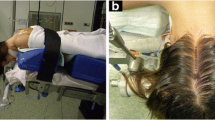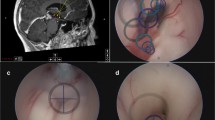Abstract
Pineal region tumors are extremely deep-seated and surgically challenging. The exposure and visualization obtained by microscopic surgery are relatively limiting. The application of high-definition endoscopes has recently provided neurosurgeons with a much more magnified and clearer view of the anatomy in the pineal region. The present study was performed to compare endoscopic-assisted surgery (ES) with microsurgery (MS) for pineal region tumors. We retrospectively analyzed patients admitted to our hospital for treatment of pineal region tumors from January 2016 to June 2019. All patients consented to undergo tumor resection with ES or MS. We compared the extent of resection, postoperative rate of hydrocephalus, complications, and outcomes between the two groups to estimate the safety and efficacy of ES. In total, 41 patients with pineal region tumors were divided into 2 groups: the ES group (n = 20) and MS group (n = 21). The rate of gross total resection was significantly higher in the ES than MS group (90.0% vs. 57.1%, p = 0.04). The rate of postoperative hydrocephalus was significantly lower in the ES than MS group (11.8% vs. 52.9%, p = 0.03). No significant differences were found in complications or the Karnofsky Performance Score between the two groups. ES can be used to safely and effectively achieve complete resection of pineal region tumors. In patients with obstructive hydrocephalus, ES provides a new way to directly open the aqueduct for cerebrospinal fluid recovery following tumor resection.

Similar content being viewed by others
References
Inoue A, Ohnishi T, Kohno S, Ohue S, Iwata S, Matsumoto S, Nishikawa M, Ozaki S, Mizuno Y, Kitazawa R, Kunieda T (2018) Identification of characteristic features of pineal germinoma that enhance accuracy of preoperative differentiation in pineal region tumors: its significance on optimum surgical treatment. Neurosurg Rev 41:197–206. https://doi.org/10.1007/s10143-017-0835-y
Sonabend AM, Bowden S, Bruce JN (2016) Microsurgical resection of pineal region tumors. J Neuro-Oncol 130:351–366. https://doi.org/10.1007/s11060-016-2138-5
Lo AC, Hodgson D, Dang J, Tyldesley S, Bouffet E, Bartels U, Cheng S, Hukin J, Bedard PL, Goddard K, Laperriere N (2019) Intracranial germ cell tumors in adolescents and young adults: a 40-year multi-institutional review of outcomes. Int J Radiat Oncol Biol Phys. https://doi.org/10.1016/j.ijrobp.2019.10.020
Liu JK, Cohen MA (2016) Endoscopic-assisted posterior interhemispheric retrocallosal transfalcine approach for microsurgical resection of a pineal region falcotentorial meningioma: operative video and technical nuances. Neurosurg Focus 40 Video Suppl 1:2016 2011 FocusVid 15453. https://doi.org/10.3171/2016.1.FocusVid.15453
Sinha S, Culpin E, McMullan J (2018) Extended endoscopic supracerebellar infratentorial (EESI) approach for a complex pineal region tumour-a technical note. Childs Nerv Syst 34:1397–1399. https://doi.org/10.1007/s00381-018-3797-7
Broggi M, Darbar A, Teo C (2010) The value of endoscopy in the total resection of pineocytomas. Neurosurgery 67:ons159–ons165. https://doi.org/10.1227/01.NEU.0000383136.40033.2D
Shahinian H, Ra Y (2013) Fully endoscopic resection of pineal region tumors. J Neurol Surg B Skull Base 74:114–117. https://doi.org/10.1055/s-0033-1338165
Abecassis IJ, Hanak B, Barber J, Mortazavi M, Ellenbogen RG (2017) A single-institution experience with pineal region tumors: 50 tumors over 1 decade. Oper Neurosurg (Hagerstown) 13:566–575. https://doi.org/10.1093/ons/opx038
Samadian M, Maloumeh EN, Shiravand S, Ebrahimzadeh K, Sharifi G, Mousavinejad A, Rezaei O (2019) Pineal region tumors: long-term results of endoscopic third ventriculostomy and concurrent tumor biopsy with a single entry approach in a series of 64 cases. Clin Neurol Neurosurg 184:105418. https://doi.org/10.1016/j.clineuro.2019.105418
Hernesniemi J, Romani R, Albayrak BS, Lehto H, Dashti R, Ramsey C 3rd, Karatas A, Cardia A, Navratil O, Piippo A, Fujiki M, Toninelli S, Niemela M (2008) Microsurgical management of pineal region lesions: personal experience with 119 patients. Surg Neurol 70:576–583. https://doi.org/10.1016/j.surneu.2008.07.019
Hoffman HJ, Yoshida M, Becker LE, Hendrick EB, Humphreys RP (1994) Pineal region tumors in childhood. Experience at the Hospital for Sick Children. 1983. Pediatr Neurosurg 21:91–103; discussion 104. https://doi.org/10.1159/000120821
Qi S, Fan J, Zhang XA, Zhang H, Qiu B, Fang L (2014) Radical resection of nongerminomatous pineal region tumors via the occipital transtentorial approach based on arachnoidal consideration: experience on a series of 143 patients. Acta Neurochir 156:2253–2262. https://doi.org/10.1007/s00701-014-2224-4
Tate M, Sughrue ME, Rutkowski MJ, Kane AJ, Aranda D, McClinton L, McClinton L, Barani IJ, Parsa AT (2012) The long-term postsurgical prognosis of patients with pineoblastoma. Cancer 118:173–179. https://doi.org/10.1002/cncr.26300
Zaidi HA, Elhadi AM, Lei T, Preul MC, Little AS, Nakaji P (2015) Minimally invasive endoscopic supracerebellar-infratentorial surgery of the pineal region: anatomical comparison of four variant approaches. World Neurosurg 84:257–266. https://doi.org/10.1016/j.wneu.2015.03.009
Konovalov AN, Pitskhelauri DI (2003) Principles of treatment of the pineal region tumors. Surg Neurol 59:250–268. https://doi.org/10.1016/s0090-3019(03)00080-6
Luo SQ, Li DZ, Zhang MZ, Wang ZC (1989) Occipital transtentorial approach for removal of pineal region tumors: report of 64 consecutive cases. Surg Neurol 32:36–39. https://doi.org/10.1016/0090-3019(89)90032-3
Mottolese C, Szathmari A, Ricci-Franchi AC, Beuriat PA, Grassiot B (2015) The sub-occipital transtentorial approach revisited base on our own experience. Neurochirurgie 61:168–175. https://doi.org/10.1016/j.neuchi.2013.12.005
Sajko T, Kudelic N, Lupret V, Lupret V Jr, Nola IA (2009) Treatment of pineal region lesions: our experience in 39 patients. Coll Antropol 33:1259–1263
Bruce JN, Ogden AT (2004) Surgical strategies for treating patients with pineal region tumors. J Neuro-Oncol 69:221–236. https://doi.org/10.1023/b:neon.0000041885.09226.2d
Rangel-Castilla L, Hwang SW, Jea A, Torres-Corzo J (2012) Efficacy and safety of endoscopic transventricular lamina terminalis fenestration for hydrocephalus. Neurosurgery 71:464–473; discussion 473. https://doi.org/10.1227/NEU.0b013e31825b1e8d
Pitskhelauri DI, Konovalov AN, Kornienko VN, Serova NK, Arutiunov NV, Kopachev DN (2009) Intraoperative direct third ventriculostomy and aqueductal stenting in deep-seated midline brain tumor surgery. Neurosurgery 64:256–266; discussion 266-257. https://doi.org/10.1227/01.NEU.0000338260.05545.84
Zhang Z, Wang H, Cheng H, Fan Y, Hang C, Sun K, Zhu L (2013) Management of hydrocephalus secondary to pineal region tumors. Clin Neurol Neurosurg 115:1809–1813. https://doi.org/10.1016/j.clineuro.2013.05.009
Lutterbach J, Fauchon F, Schild SE, Chang SM, Pagenstecher A, Volk B, Ostertag C, Momm F, Jouvet A (2002) Malignant pineal parenchymal tumors in adult patients: patterns of care and prognostic factors. Neurosurgery 51:44–55; discussion 55-46. https://doi.org/10.1097/00006123-200207000-00006
Santos de Oliveira R, Barros Juca CE, Valera ET, Machado HR (2008) Hydrocephalus in posterior fossa tumors in children. Are there factors that determine a need for permanent cerebrospinal fluid diversion? Childs Nerv Syst 24:1397–1403. https://doi.org/10.1007/s00381-008-0649-x
Steiger HJ, Gotz C, Schmid-Elsaesser R, Stummer W (2000) Thalamic astrocytomas: surgical anatomy and results of a pilot series using maximum microsurgical removal. Acta Neurochir 142:1327–1336; discussion 1336-1327. https://doi.org/10.1007/s007010070001
Author information
Authors and Affiliations
Corresponding author
Ethics declarations
Conflict of interest
The authors declare that they have no conflicts of interest.
Ethical approval
The current study was approved by the ethical committee of our hospital.
Informed consent
Informed consent was obtained for all enrolled patients.
Additional information
Publisher’s note
Springer Nature remains neutral with regard to jurisdictional claims in published maps and institutional affiliations.
Can Xin and Zhongwei Xiong are co-first authors
Rights and permissions
About this article
Cite this article
Xin, C., Xiong, Z., Yan, X. et al. Endoscopic-assisted surgery versus microsurgery for pineal region tumors: a single-center retrospective study. Neurosurg Rev 44, 1017–1022 (2021). https://doi.org/10.1007/s10143-020-01283-6
Received:
Revised:
Accepted:
Published:
Issue Date:
DOI: https://doi.org/10.1007/s10143-020-01283-6




